Picture this: Paris Hilton stepping out of a limo in 2004, white Monogram Multicolor bag in hand, paparazzi flashing. Now cut to 2025—Zendaya fronting campaign imagery with that same iconic print. Two different eras, one unmistakable silhouette.
It’s the perfect reflection of what’s happening in fashion right now: a deliberate return to nostalgia. Consumers are craving pieces that feel familiar, collectible, and emotionally resonant. The resurgence of early-2000s luxury—especially styles like Monogram Multicolor—isn’t just a trend; it’s a response to a broader cultural shift toward comfort, memory, and timeless statement pieces that still hit today.
The Louis Vuitton and Takashi Murakami collaboration didn’t just create handbags, it rewrote the rules of luxury, while generating over $300 million in the first year. It had shoppers in a choke hold and resellers charged double retail pricing while 7,000-name waitlists bloomed. When the collaborations ended around 2015, vintage pieces became investment-grade collectibles. Now they’re back, and the fashion world is losing its mind all over again.
This is the complete story of how a Japanese artist and an American fashion rebel created something that belongs in both museums and closets—and why 2025 is absolutely the year to understand what you’re buying into.
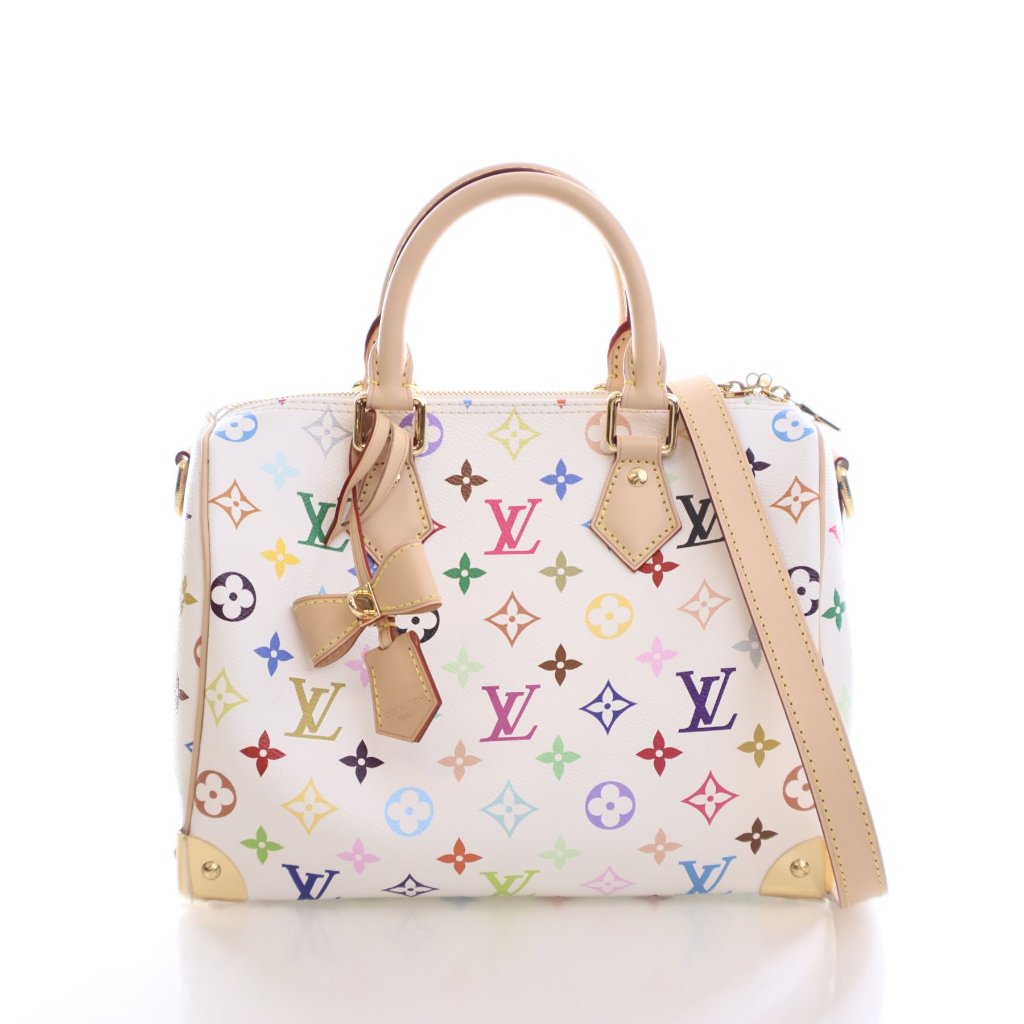
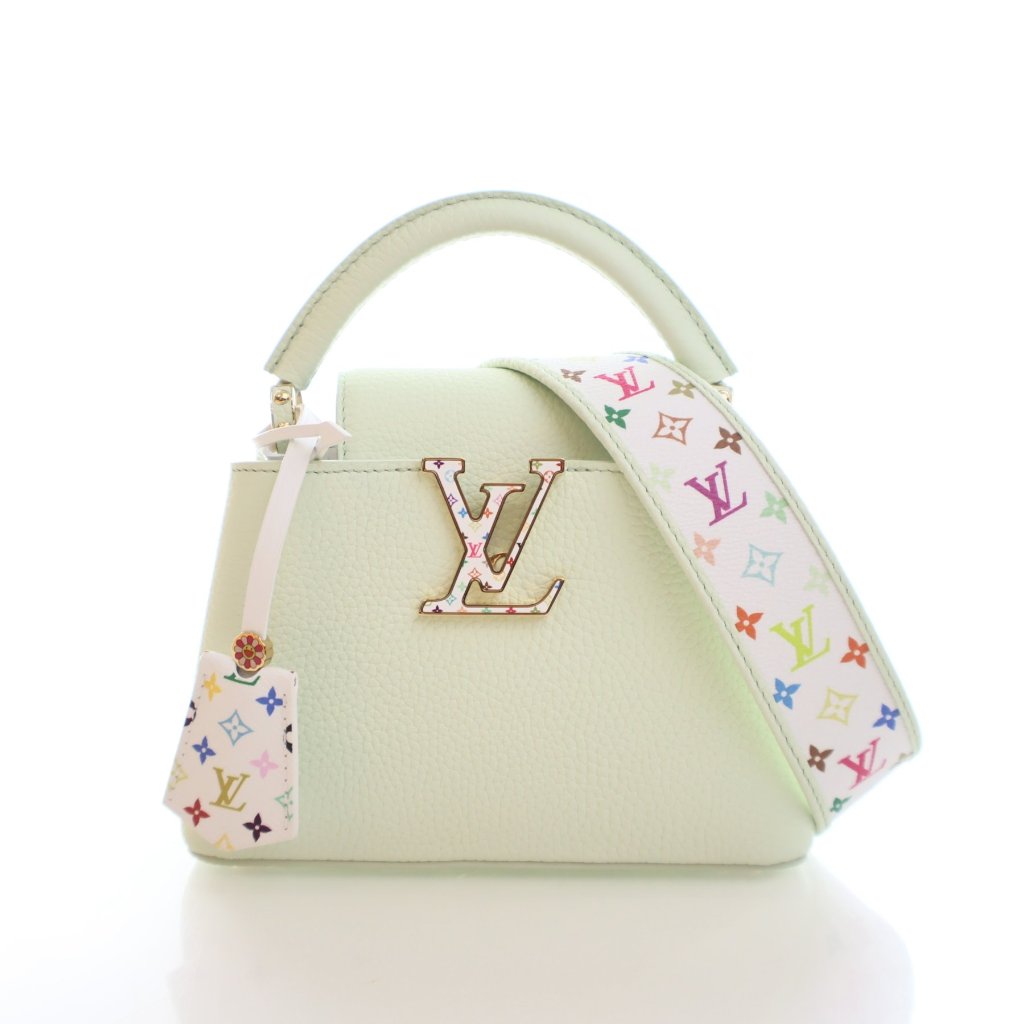
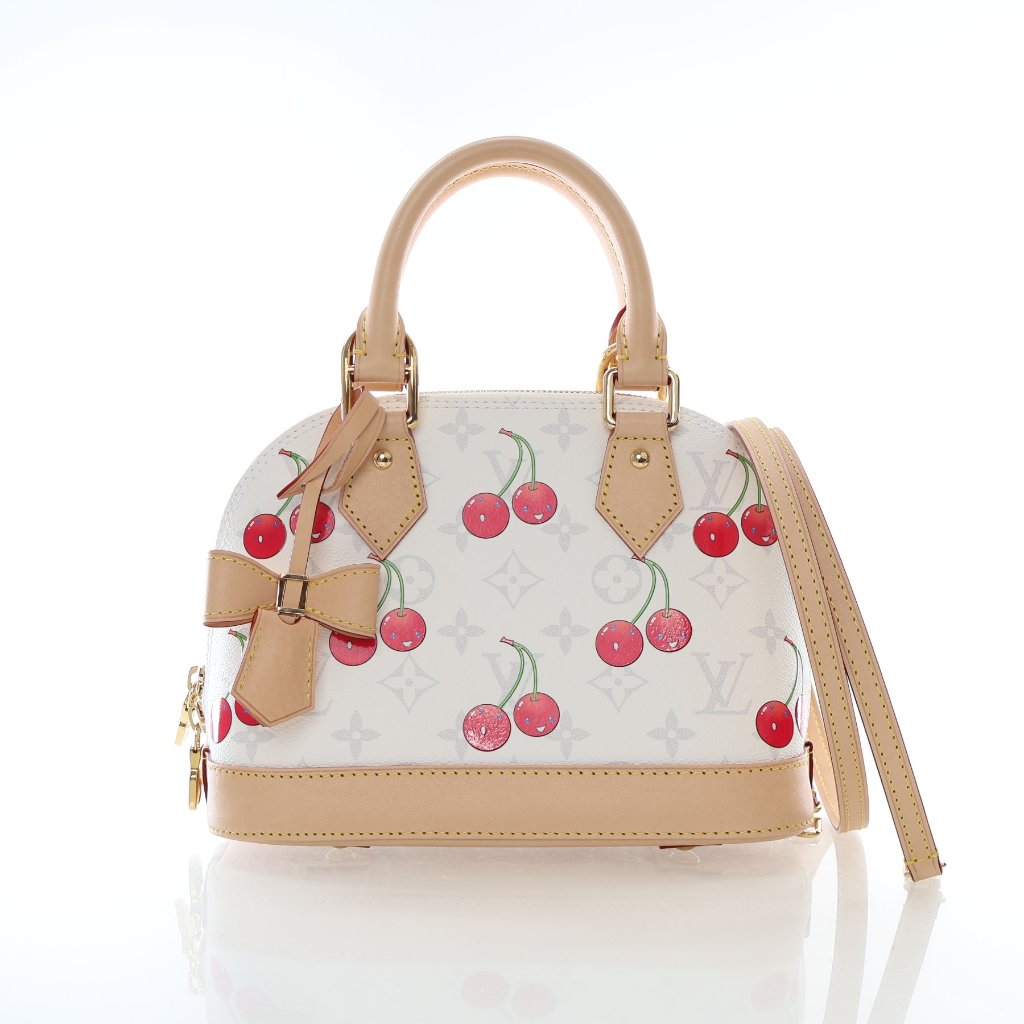
The History Behind the Most Iconic Fashion Collaboration
How Marc Jacobs and Takashi Murakami Rewrote The Rules of Luxury
Marc Jacobs was six years into his role as Louis Vuitton’s artistic director when he attended a Takashi Murakami exhibition at Paris’s Fondation Cartier in 2002. The artist’s vibrant, anime-inspired work stopped him cold. Jacobs sent an email asking if Murakami would be interested in collaborating, and the artist said yes without hesitation.
What happened next was unprecedented. Jacobs had worked with artists before—Stephen Sprouse’s graffiti in 2001, Julie Verhoeven’s patchwork in 2002—but they’d decorated the monogram. Murakami reimagined it entirely. He replaced the sacred brown and gold with candy colors on stark white and black fields, drawing from manga aesthetics and traditional Japanese family crests that had originally inspired Georges Vuitton’s 1896 design.
The Spring/Summer 2003 runway debut caused chaos. In Paris, the collection sold out in hours. eBay resellers commanded twice the roughly $2,000 retail price. Those unwilling to wait hit Canal Street for knockoffs. The bags appeared on Naomi Campbell, Jessica Simpson, Madonna, and even Regina George in Mean Girls.
The Prints and Patterns That Defined a Generation
The collaboration spanned 12 years and multiple collections, each with its own personality. The Monogram Multicolor featured 33 vivid colors emblazoned on either black or white coated canvas. Hot pink, turquoise, yellow, and kelly green breathed new energy into classic Louis Vuitton silhouettes like the Alma, Speedy, and Keepall.
The Cherry Blossoms followed in 2003, featuring smiling flowers with cartoon faces that paid homage to Japanese heritage. The Panda collection arrived in 2004 with Murakami’s Superflat aesthetic. Cerises came in 2005 with playful cherries dancing across the monogram. Each release sold out immediately, creating a secondary market frenzy.
The MOCA Hands collection in 2007, created for the Museum of Contemporary Art Los Angeles exhibition, became one of the rarest iterations of the Neverfull. Monogramouflage launched in 2008, blending military camo with the LV monogram in khaki and green tones. Cosmic Blossom rounded out the collaboration in 2010 with metallic finishes and space-age florals.
Why Louis Vuitton Discontinued the Line in 2015 (And What Happened to Prices)
When Marc Jacobs left Louis Vuitton in 2014, his successor Nicolas Ghesquière took the brand in a different direction. The Murakami collaborations were quietly discontinued in 2015, and something interesting happened: prices didn’t immediately spike. Collectors and vintage dealers scooped up pieces at relatively affordable rates, viewing them as outdated Y2K relics.
That changed in late 2018 when Kim Kardashian bought black Mini Speedys for the entire Kardashian-Jenner clan during a Japan trip. Suddenly, the bags were cool again. Resale prices began climbing steadily, especially as Gen Z discovered the collaboration through social media and the Y2K aesthetic roared back to the forefront of fashion.
By late 2023, when rumors of a Murakami revival started circulating on PurseForum, vintage prices jumped in demand dramatically. The white Monogram Multicolor Pochette that collectors had purchased for under $1,000 a few years earlier was suddenly commanding $1,400 or more.
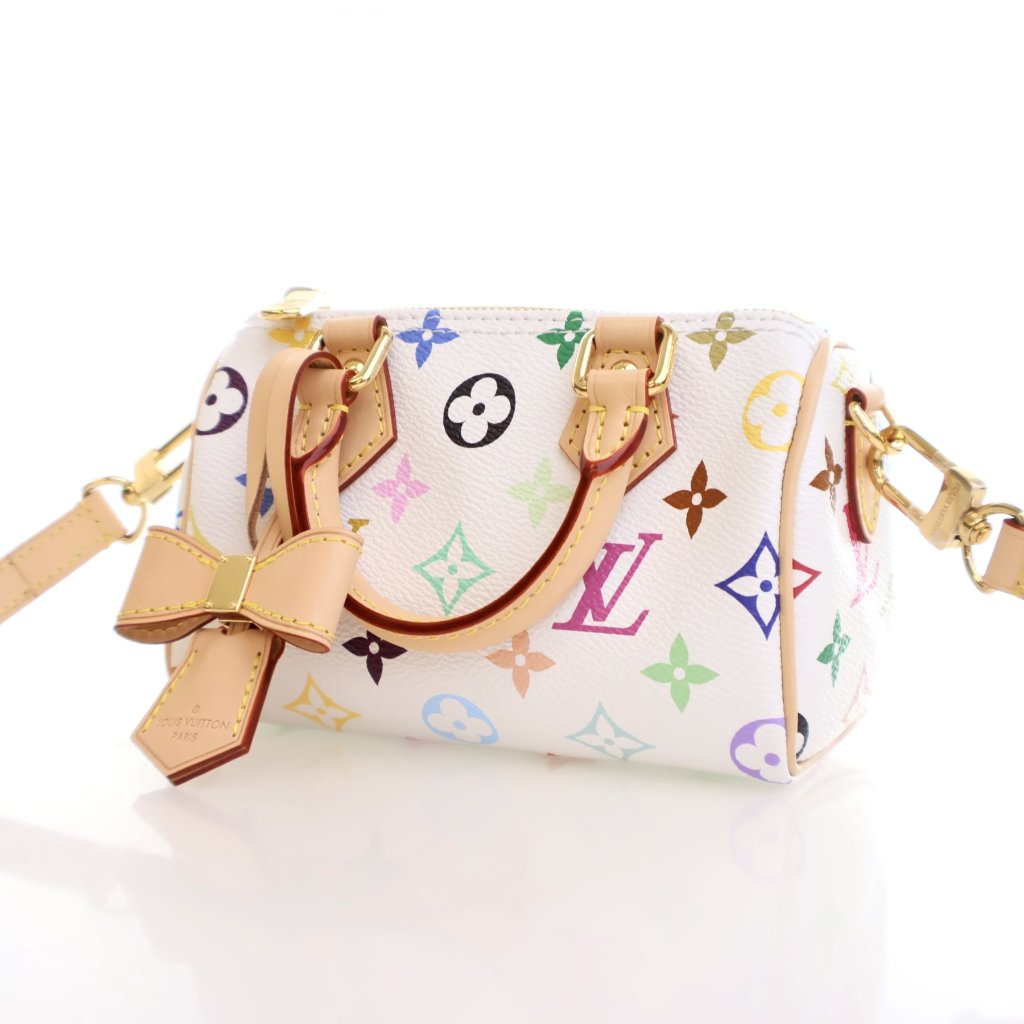
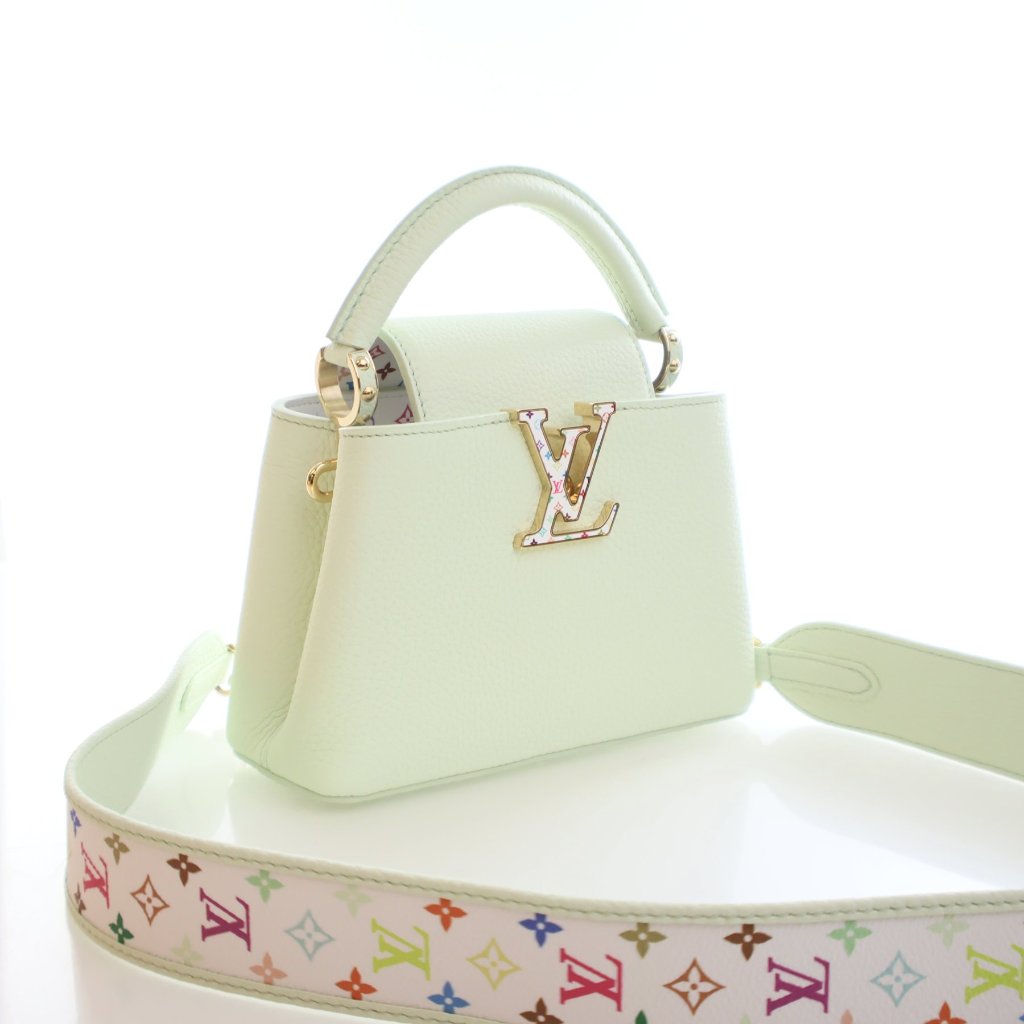
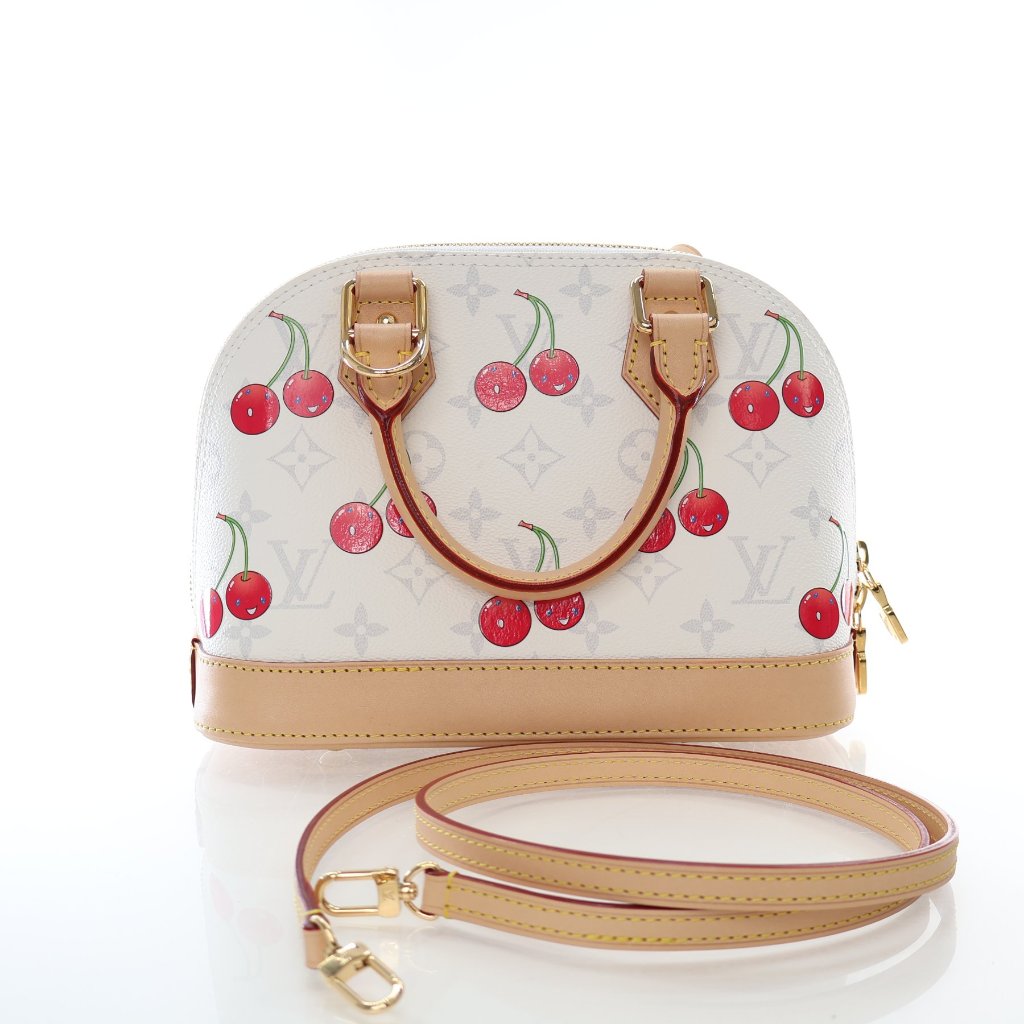
Every Murakami x Louis Vuitton Collection: A Complete Breakdown
Monogram Multicolor (2003) – The One That Started It All
The Monogram Multicolor debuted on the Spring/Summer 2003 runway and immediately became the “It” bag. The collection came in two colorways: white canvas with vibrant multicolor monogram, and black canvas for a more sophisticated look. Both versions featured brass hardware and the traditional Vuitton craftsmanship guests expected.
Iterations ranged from well-known styles like the Pochette Accessoires and Speedy 30, all the way to the Marilyn Trunk — a specially designed piece created to house an entire collection of Marilyn bags in nearly every color trim of the rainbow. Each piece transformed a familiar silhouette into something entirely new—luxury meets pop art meets street culture. Jennifer Lopez became the face of the fall 2003 campaign, photographed with the black Monogram Multicolor Dalmatian Sac Rabat.
The Eye Love Monogram Multicolor variation within this collection added Murakami’s signature eye motifs across a handful of ultra-limited styles—most notably the Eye Love You, Eye Dare You, Eye Need You, and Eye Miss You bags—creating an even more playful, surreal aesthetic that has turned these numbered pieces into some of the most aggressively hunted Murakami-era Louis Vuitton collectibles today.
Cherry Blossom, Panda, and Cerises – The Playful Collections
These three collections leaned into Murakami’s kawaii aesthetic. Cherry Blossom (2003) featured smiling flowers with cartoon faces scattered across cream-colored canvas. The sweetness factor was off the charts, making these pieces particularly popular among younger collectors and those who wanted something distinctly different from traditional luxury.
Panda (2004) introduced Murakami’s Superflat Panda character to bags, keychains, and accessories. The minimalist panda faces against the monogram canvas created a Zen-meets-cute aesthetic that appealed to collectors who found the Monogram Multicolor too vibrant.
Cerises (2005) brought hand-painted cherries with smiling faces to the collection. These limited pieces featured red cherries on cream or classic brown canvas and became instant collectibles due to their shorter production run.
Monogramouflage and MOCA Hands – The Rare Investment Pieces
If you’re looking for historically strong, highly collectible Murakami pieces, these are the standouts. Monogramouflage launched in 2008 with an original retail of about $1,500 UD for the Speedy 35. Over the years, its secondary-market value has climbed significantly — for example, some now resell above $7,500 USD — illustrating how demand for this collection has evolved since its release.
The MOCA Hands collection, produced exclusively for Murakami’s 2007 Museum of Contemporary Art exhibition, features his signature hand motifs integrated across the canvas. Because it was tied to a museum exhibit, made in limited quantities, and includes one of the few collaboration style Louis Vuitton Neverfulls in a GM size, it has consistently attracted collectors who view these pieces as wearable art rather than standard seasonal releases.
Both collections resonate with buyers who want pieces that are less common than the playful Multicolor line, but still carry the cultural impact and creative legacy of the Murakami–Louis Vuitton collaboration.

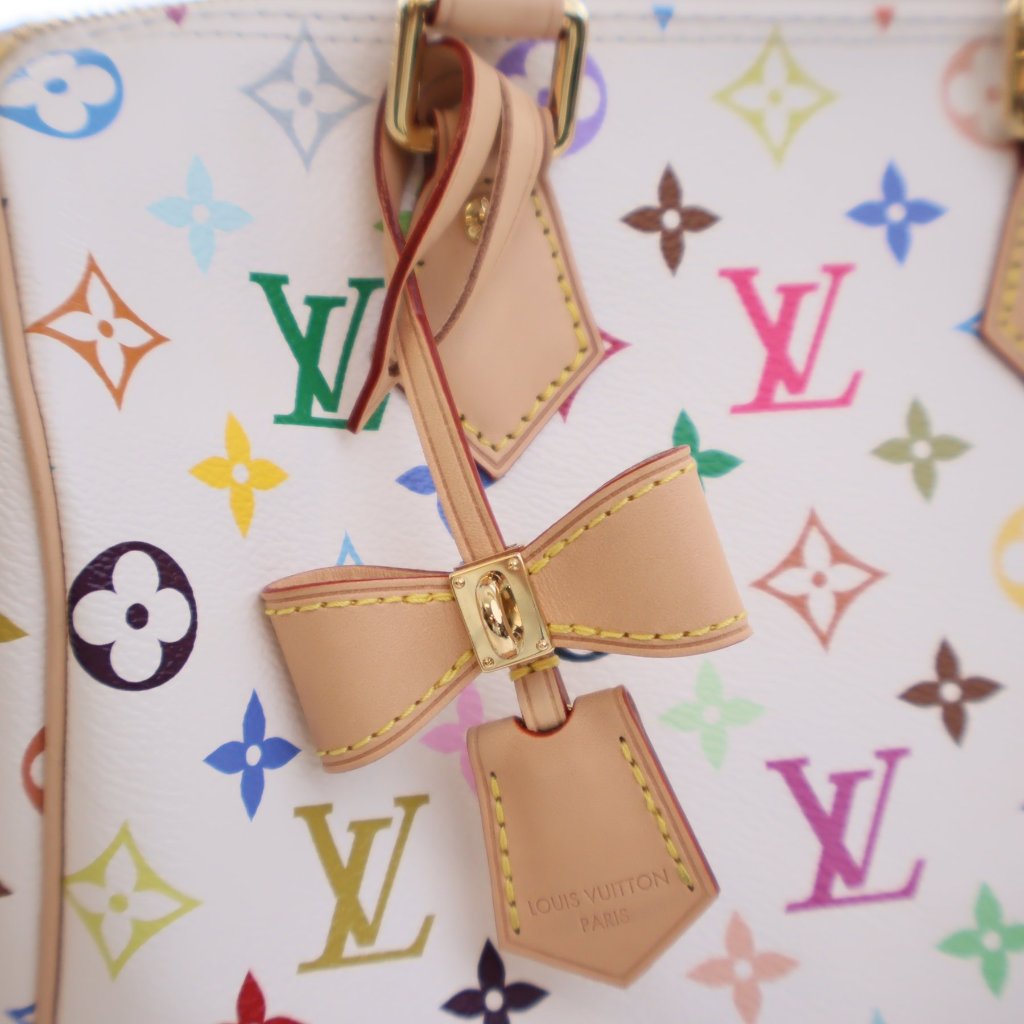

What Were Original Murakami LV Pieces Worth? (And What Are They Worth Today?)
Original Retail Prices vs. 2025 Resale Values
Let’s talk numbers. A Monogram Multicolor Pochette Accessoires retailed for approximately $450 USD in 2003. That same piece, in good condition, regularly sold for $800-$1,400 USD in the years leading up to the 2025 re-edition announcement. When re-edition rumors heated up in November 2024, prices spiked even higher.
The Speedy 30 in Monogram Multicolor originally retailed around $1,200. Today, authenticated vintage versions command $1,800-$2,500 USD depending on condition. The more structured Alma PM, which retailed for roughly $1,500 USD, now sells for $2,000-$3,000 USD in the resale market.
Cherry Blossom Pochettes that once retailed for approximately $1,290 USD now sell for similar prices or slightly higher if they’re in pristine condition, though the limited production means finding one is the real challenge.
The Math on Value Appreciation: Did These Bags Beat Inflation?
Here’s where it gets interesting. Adjusted for inflation, that $450 USD Pochette from 2003 would cost about $760 USD today. If you bought it at retail and sold it for $1,200 USD in 2024, you beat inflation by roughly 58%. Not bad for a handbag that you probably carried and enjoyed.
The Monogramouflage Speedy 35 tells an even better story. The $1,500 USD retail price in 2008 adjusts to roughly $2,100 SUD today. At a $9,000+ USD resale price, that’s a 500% return over 13 years—beating the S&P 500’s performance during the same period.
Of course, condition matters tremendously. A well-maintained piece with original packaging commands premium prices. Worn pieces still hold value better than most fashion items, but they won’t deliver investment-grade returns.
Which Styles Hold Value Best (And Which Don’t)
Small leather goods and accessories typically don’t appreciate like bags do. Wallets, key holders, and scarves rarely see significant value increases but do retain much of their original value as a result of the collection’s greater popularity.
The Speedy silhouette holds value exceptionally well across all Murakami prints. Its iconic shape, practical size, and status as a signature style make it perpetually desirable. The Alma follows closely behind, particularly in the newest BB size that works for modern lifestyles.
Monogramouflage pieces command the highest premiums in the resale market. The limited production run, sophisticated aesthetic, and time elapsed since discontinuation create perfect conditions for appreciation. Cherry Blossom and Panda pieces appeal to niche collectors but don’t see the same broad market demand as Monogram Multicolor or Monogramouflage.
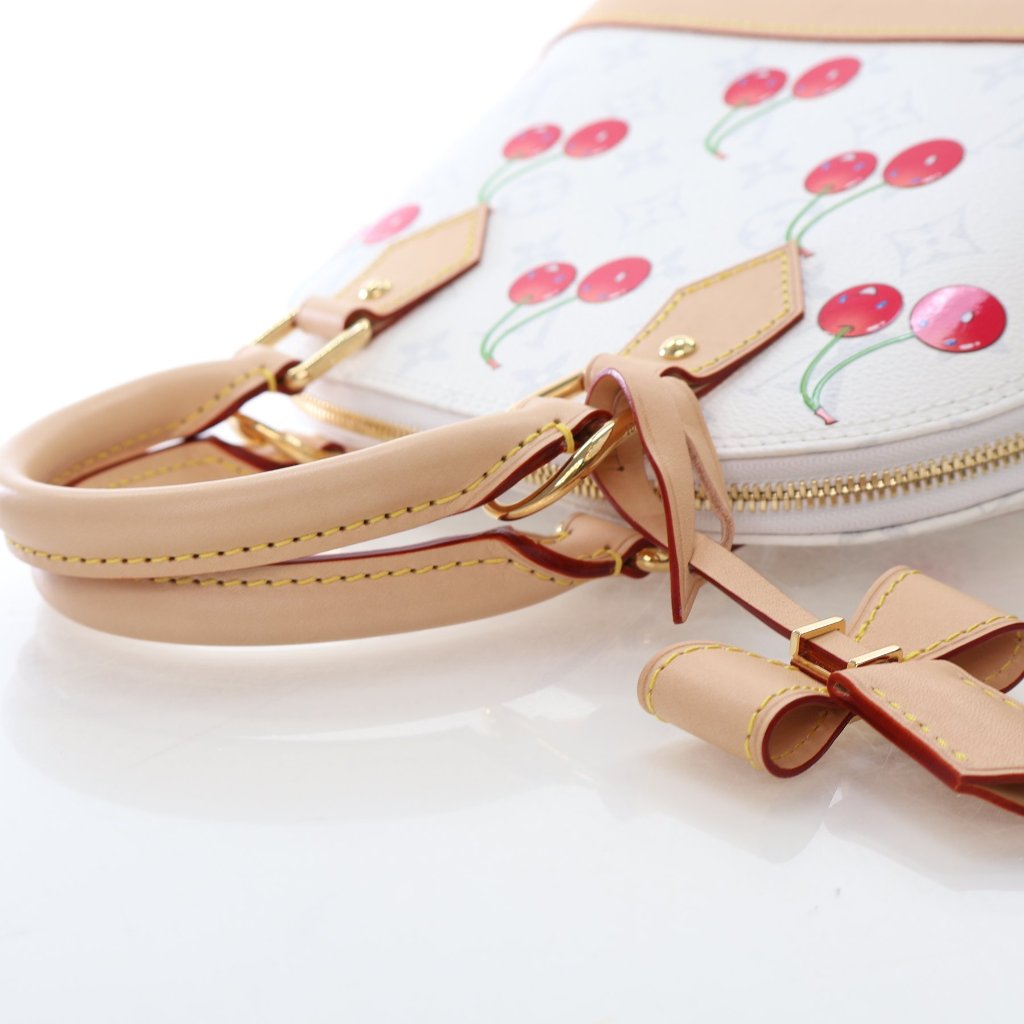
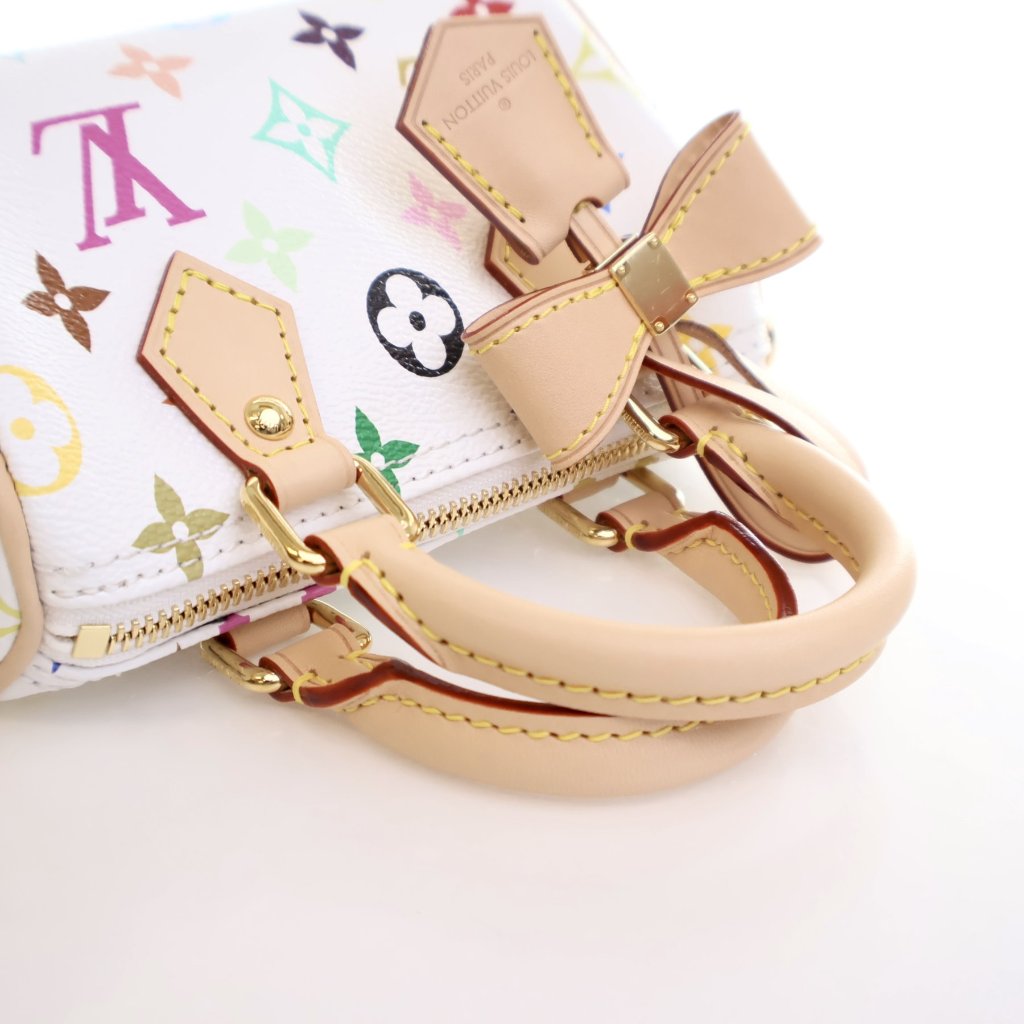
The 2025 Re-Edition: What’s New, What’s Different, and What It Costs
Inside the Three-Chapter Relaunch Strategy
Louis Vuitton structured the 2025 re-edition as a three-chapter story. Chapter One dropped in January 2025, featuring the iconic Monogram Multicolor monogram across more than 170 pieces. This wasn’t just bags—the collection included perfume, belts, sunglasses, espadrilles, and even a skateboard.
Chapter Two arrived later with the Cherry Blossom reissue, celebrating spring with the smiling flowers that defined the collection’s playful spirit. Chapter Three closed the trilogy with additional Cherry motifs and seasonal pieces.
Campaign star Zendaya replaced Paris Hilton and Lindsay Lohan as the face of the collaboration, signaling a generational shift while maintaining the same It-girl energy that made the original collection iconic. Pop-up shops opened in major cities worldwide, creating immersive Murakami environments that went viral on social media.
How New Technology Made the Colors More Vibrant
Here’s something collectors noticed immediately: the 2025 pieces look even more vibrant than the originals. Two decades of advances in printing technology allowed for unprecedented definition in the prints. The colors are more resplendent, the precision of Murakami’s motifs sharper, and the overall effect more striking.
This technological leap means 2025 pieces aren’t exact replicas—they’re enhanced versions that maintain the spirit while improving the execution. Some vintage collectors prefer the original production techniques, viewing them as more authentic to the era. Others appreciate the crisp, modern interpretation.
The question becomes: are you buying nostalgia or quality? The answer depends on what story you want your bag to tell.
Pricing the Re-Edition: From $250 Scarves to $51,000 Panda Clutch
The 2025 re-edition pricing spans from $250 for silk scarves to $8,050 Capucines. A Speedy 25 retails for approximately $3,000 USD, while The Alma BB sits at roughly $2,660 USD. The CarryAll PM, a modern silhouette not available in the original run, costs about $3,285 USD.
Comparing these to original prices reveals significant inflation. That 2003 Pochette that retailed for $450 would likely cost $800-$1,000 USD in the 2025 collection (with a recent re-issue with chain at $2100 USD). The premium reflects both two decades of luxury price increases and the enhanced production quality.
Accessories provide more accessible entry points. Scrunchies, phone cases, and small leather goods start under $500, letting fans of the collaboration own something without breaking into their designer bag investments.

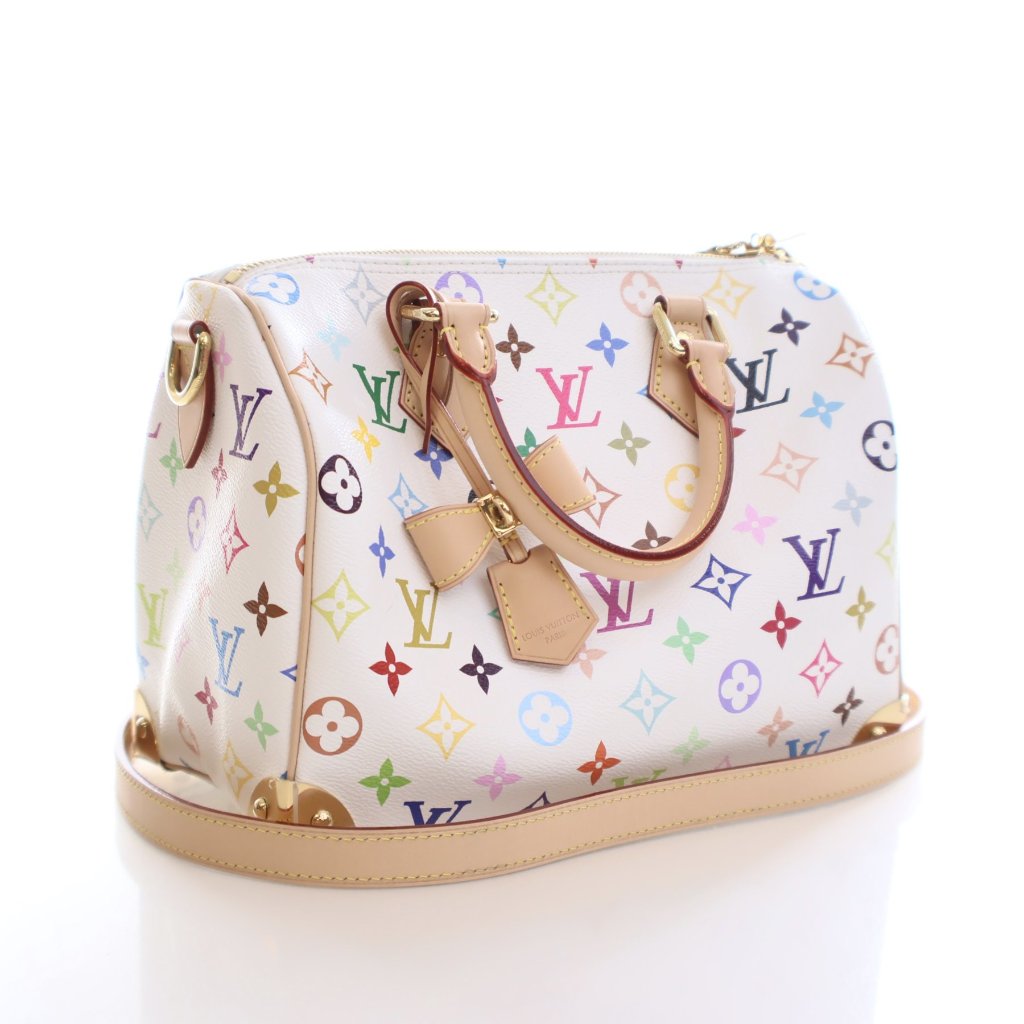
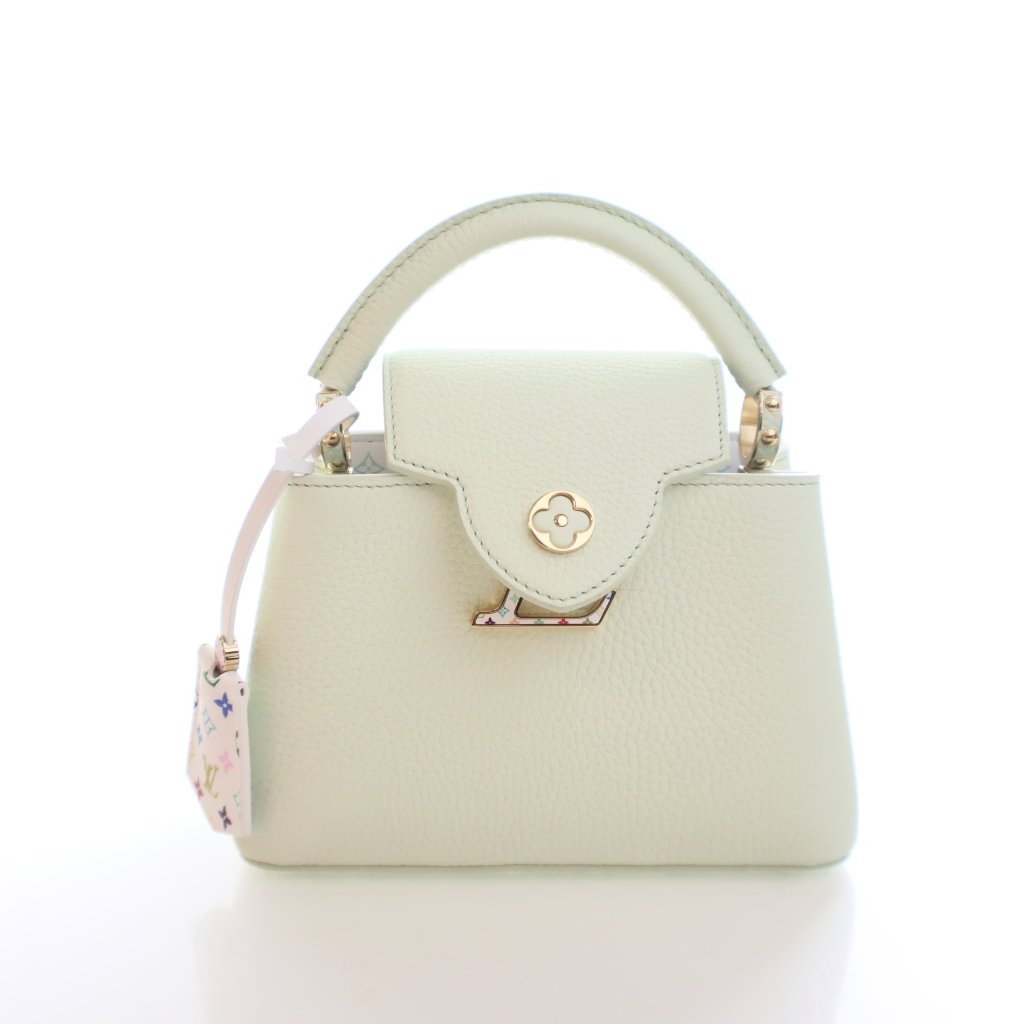
Artycapucines VII: The Ultra-Rare Art Pieces You Can Actually Carry
11 Bags That Cost As Much As Fine Art (And Why)
While the re-edition brought Murakami’s aesthetic to the masses, the Artycapucines VII collection aimed at serious collectors and art enthusiasts. Unveiled at Art Basel Paris in October 2025, these 11 highly limited-edition pieces reimagine the Capucines bag as wearable sculpture.
Each bag exists in extremely limited quantities—some rumors suggest fewer than 50 pieces per design worldwide. They’re priced accordingly, with estimates ranging from $20,000 to well over $50,000 depending on complexity and materials. At these price points, you’re not buying a handbag; you’re acquiring a Murakami artwork that happens to have a functional purpose.
The collection includes the Capucines BB Golden Garden, adorned with gold-leaf-covered leather and intricate floral marquetry. The Capucines Mini Mushroom features over 100 hand-polished resin mushrooms on mirrored canvas. The Capucines East West Dragon recreates Murakami’s 18-meter Dragon in Clouds painting on a bag structure.
The $51,000 Panda Clutch with 6,250 Hand-Set Crystals
The showstopper? The Panda Clutch, of 130 made, is a sculptural masterpiece crafted from lustrous silver-tone brass and adorned with 6,250 hand-set crystals. This isn’t a bag you carry to brunch. It’s a museum piece that happens to have a clasp and room for your essentials.
The Capucines XXL Camo represents another extreme: the first oversize, unisex interpretation of the Capucines. Featuring Murakami’s skull-in-camouflage pattern on washed denim, it’s designed for collectors who want statement pieces that blur gender boundaries and challenge traditional luxury aesthetics.
The Capusplit BB transforms the classic Capucines into a double-layered surprise. The outer shell in light blue crocodile leather reveals an internal panel in vibrant Monogram Monogram Multicolor on white lambskin—a sophisticated nod to the collection that started everything.
Limited Editions vs. Standard Re-Releases: Understanding Scarcity
This is critical for anyone considering purchase: not all 2025 Murakami pieces are created equal. The standard re-edition collection, while selling out quickly, will likely see restocks and ongoing production for the foreseeable future. These pieces will hold value but likely won’t appreciate dramatically in the short term.
The Artycapucines VII pieces are numbered, limited editions that will never be reproduced. Each comes with documentation, special packaging, and a connection to the Art Basel Paris exhibition. These are the pieces positioned for a select few and very specific demand.
Between these extremes sit special releases like the Cherry Blossom chapter pieces and certain colorways that see limited production runs. Understanding which category your purchase falls into matters if you care about long-term value retention.
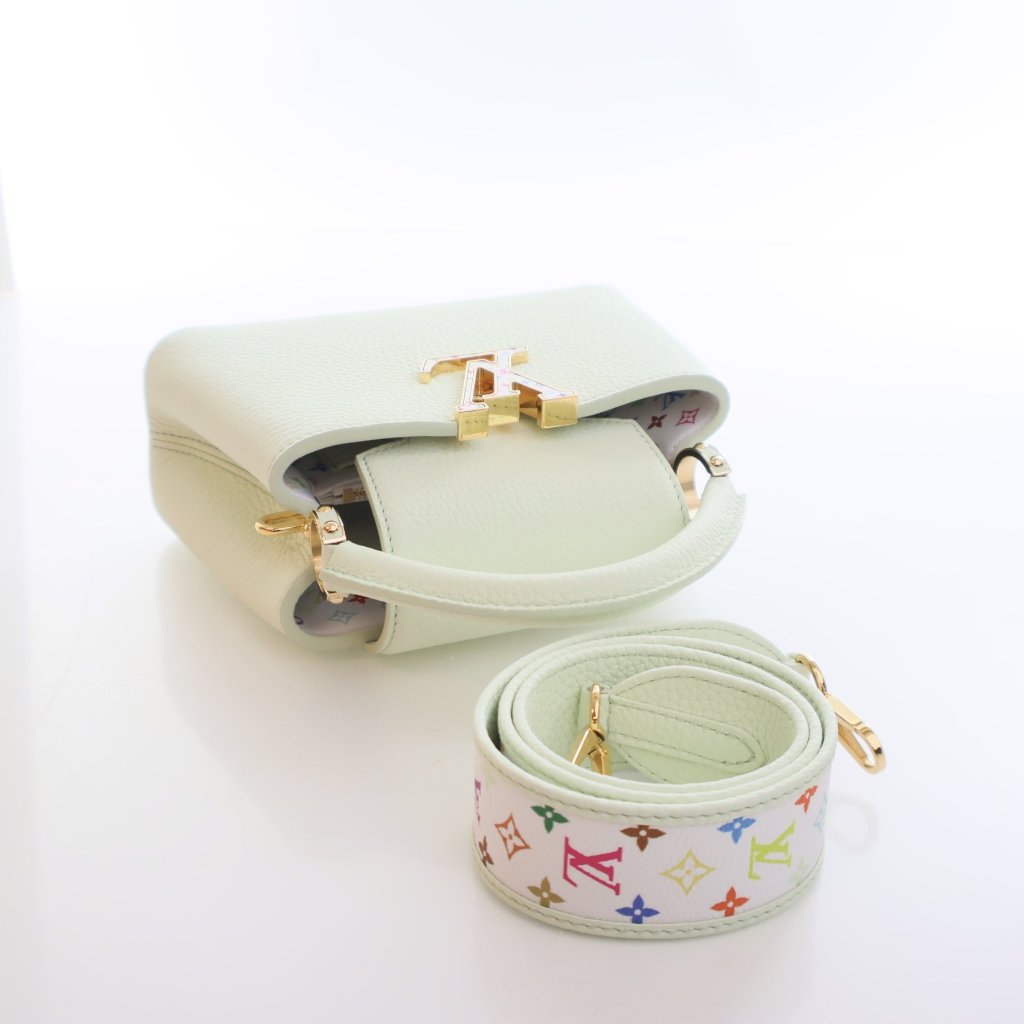

Why Is 2025 the Year of Murakami?
From MLB to Casetify: Murakami’s 2025 Collaboration Takeover
The Louis Vuitton re-edition isn’t happening in isolation. Murakami launched a massive MLB collaboration in March 2025 for the Tokyo Series, featuring the Los Angeles Dodgers and Chicago Cubs. Ultra-rare Sakura Elite jerseys retailed for $2,000, with fewer than 40 pieces available. The collection sold out in minutes.
Casetify partnered with Murakami for three separate collections in 2025: Mr. DOB in April, Kaikai and Kiki in July, and Flowers Bloom in October. Tech accessories adorned with Murakami’s characters ranged from $49 phone cases to $699 limited-edition suitcases. Each launch crashed websites and created waitlists.
This saturation might concern collectors worried about overexposure. But here’s the thing: each collaboration targets different audiences and price points. The MLB collection appeals to sports fans. Casetify serves tech enthusiasts. Louis Vuitton remains the prestige collaboration that serious fashion collectors and investors focus on.
The Nostalgia Economy and Y2K Fashion’s Comeback
We’re living through a nostalgia boom driven by millennials with disposable income and Gen Z discovering pre-Instagram era aesthetics. Y2K fashion—low-rise jeans, baby tees, butterfly clips, and yes, colorful logo-heavy bags—have come back into style.
The original Murakami collaboration happened at the absolute peak of Y2K culture. Bringing it back now taps into powerful emotional connections for millennials who remember lusting after these bags in their teens and twenties. Now they have the income to actually buy them.
For Gen Z, the collaboration represents discovered treasure from a pre-social media era when celebrity paparazzi photos and fashion magazines were how trends spread. The aesthetic feels fresh to them precisely because it’s removed from today’s minimalist luxury trends.
Celebrity Influence: How Zendaya Made It Cool Again
Celebrity endorsement matters in luxury fashion, and Zendaya’s involvement in the 2025 campaign created cultural permission for a new generation to embrace these pieces. She’s been photographed carrying various Murakami styles throughout 2025, styling them with everything from red carpet gowns to casual street style.
Rihanna has also been spotted with original collaboration pieces recently, reminding everyone that vintage Murakami never left the rotation of true fashion insiders. Kendall Jenner owns multiple pieces from both eras. These aren’t influencers paid for posts; they’re genuine collectors who appreciate the bags’ cultural significance.
The celebrity factor drives demand but shouldn’t solely determine your purchase decisions. Buy because you love the aesthetic and understand the investment thesis, not just because someone famous carried one on Instagram.
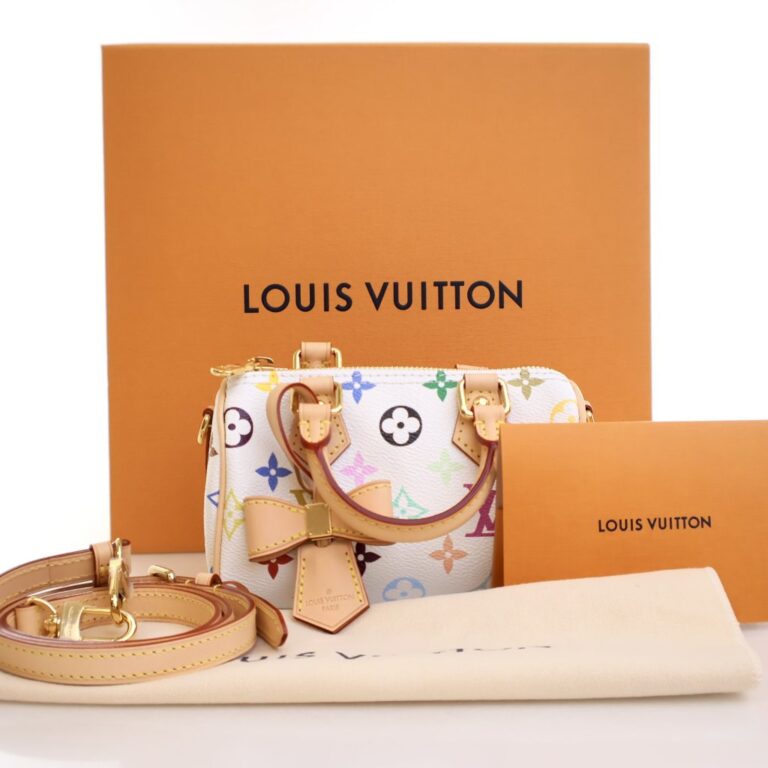
The Legacy Continues
The Takashi Murakami Louis Vuitton collaboration proved that art and commerce could create something bigger than either discipline alone. It democratized contemporary art by making it wearable and accessible. It elevated fashion by treating handbags as canvases worthy of museum exhibitions. Marc Jacobs called it “a monumental marriage of art and commerce”, and 22 years later, that description still feels inadequate.
Historically, the pieces that have resold most consistently with a strong ROI share a few common traits: iconic silhouettes, excellent condition, and collaborations that have maintained long-term collector interest. But the pieces that matter most on a personal level? Those are the ones you genuinely love carrying — regardless of how the market moves.
Check back for new updates on developments in the world of Luxury here at Luxe Du Jour. We are luxury reimagined | Authentic and Accessible.
